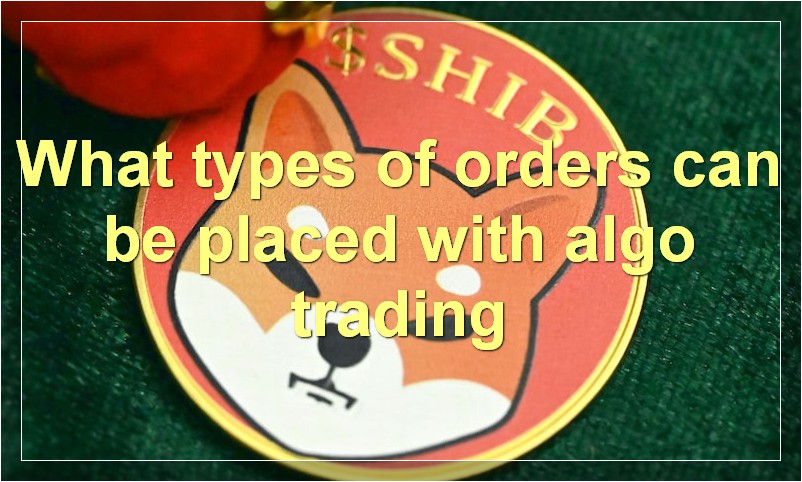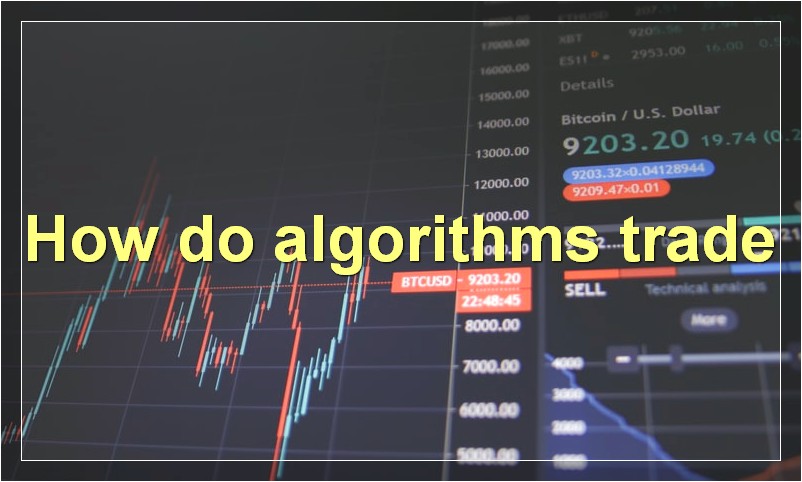Are you interested in making money through trading but don’t have the time to do it yourself? Algorithmic trading might be for you!
What is algo trading
Algorithmic trading, also called algo trading, is a type of trading that uses computer programs to automatically make trading decisions. The trade execution and decision-making process is completely automated, which means there is no human involvement. Algorithmic trading can be used in any market where electronic trading is allowed, including stocks, bonds, foreign exchange, and commodities.
Algorithmic trading has become very popular in recent years because it can execute trades faster and more accurately than humans. It can also place orders for multiple securities at the same time, which is not possible with manual trading.
There are several benefits of algorithmic trading, including:
1. Speed: Algorithmic trading can place orders much faster than humans. This is important in markets where every second counts, such as the foreign exchange market.
2. Accuracy: Algorithmic trading can execute orders with great accuracy. This is because the computer program follows a set of rules and instructions that are based on market conditions.
3. Cost savings: Algorithmic trading can save you money on commissions and fees. This is because the trade execution is done electronically and there are no middlemen involved.
4. Increased market liquidity: Algorithmic trading can increase market liquidity by placing orders for multiple securities at the same time. This increases the chances of your order being filled at the best possible price.
5. Reduced risk: Algorithmic trading can help you manage risk by following pre-determined rules and instructions. This way, you will know exactly how much you are willing to lose on each trade before you even place it.
If you are thinking about starting algorithmic trading, there are several things you need to know. First, you need to choose a broker that offers this type of trading. Second, you need to find a good computer program that will do the actual trading for you. Third, you need to backtest the program to make sure it works well in different market conditions. Fourth, you need to paper trade with the program to see how it would have performed in real-world conditions. And finally, you need to start live trading with small amounts of capital to minimize your risk.
How do algorithms trade

Algorithms trade by looking at the market data and making decisions based on that data. They take into account the prices of the assets, the volume of the trade, and the time of the trade. By doing this, they can make trades that are more likely to be profitable.
Who uses algo trading
There is no one definitive answer to this question, as algo trading can be employed by a wide variety of individuals and organizations. In general, algo trading refers to the use of computer programs to automate the process of buying and selling securities. This can be done either through pre-programmed rules or by using artificial intelligence (AI) to make decisions in real-time.
Algo trading is often used by large institutional investors, such as hedge funds and investment banks, as it allows them to make trades quickly and efficiently. These firms typically have access to large amounts of data and sophisticated software that individual investors do not. For example, a bank may use an algorithm to automatically buy or sell a currency pair when it reaches a certain price.
Some retail investors also use algo trading, either through specialised software or by working with a broker that offers this service. Algo trading can be beneficial for retail investors as it can help them to execute trades faster and at a lower cost than if they were to do so manually.
What benefits does algo trading offer
Algorithmic trading, also known as algo trading, is a trading strategy that uses computer programs to automatically make trades on an exchange. Algo trading is used by a growing number of institutional investors and individual traders to execute trades at high speeds and with high accuracy.
There are many benefits of algo trading, including:
1. Speed: Algorithmic trading can place orders in milliseconds, which is faster than any human trader can do. This speed advantage can be significant in volatile markets where every second counts.
2. Accuracy: Algorithmic trading eliminates emotions and human error from the trading process. This results in more accurate trade execution and improved order placement.
3. Cost-effectiveness: Algorithmic trading can save you money on commissions and fees because it can trade at a much higher frequency than a human trader.
4. Increased market liquidity: By providing more liquidity to the market, algo trading helps to reduce spreads and make it easier for other traders to get the prices they want.
5. Better risk management: Algorithmic trading can help you manage your risk better by automatically placing stop-loss orders and scaling back your position size when necessary.
What are the risks associated with algo trading
Algorithmic trading, or algo trading, is a type of trading that uses computer-generated programs to automatically make trades. Algo trading is often used by large institutional investors and hedge funds because it allows them to trade quickly and efficiently.
However, there are some risks associated with algo trading. One risk is that the algorithms may not be able to accurately predict market conditions. This could lead to trades being made that lose money for the investors.
Another risk is that the algorithms may be exploited by malicious traders who are able to understand how they work. These traders could use this information to make trades that would cause prices to move in a way that is beneficial to them but harmful to others.
Finally, algo trading can sometimes contribute to market volatility. This is because the algorithms may place buy or sell orders in a way that causes prices to fluctuate more than they would if the orders were placed manually. This can create a more volatile market which can be difficult for investors to navigate.
What types of orders can be placed with algo trading

There are a few different types of orders that can be placed with algo trading. Some of these include:
1) Limit orders: A limit order is an order to buy or sell a security at a specified price or better.
2) Stop orders: A stop order is an order to buy or sell a security when it reaches a specified price.
3) Market orders: A market order is an order to buy or sell a security at the current market price.
4) Trailing stop orders: A trailing stop order is an order to buy or sell a security when it reaches a price that is lower than the current market price (for a sell order), or higher than the current market price (for a buy order).
How does algo trading impact markets
Algorithmic trading, or algo trading, is a type of trading that uses computer programs to automatically make trading decisions. These decisions are based on mathematical models that take into account things like market trends, price movements, and order imbalances. Algo trading is used by banks, hedge funds, and institutional investors to trade large amounts of securities quickly and efficiently.
Algorithmic trading has had a significant impact on markets around the world. It has made them more efficient and liquid, and has allowed for more accurate pricing of assets. It has also made it easier for small investors to trade in the markets.
What are some common strategies used in algo trading
Algorithmic trading, or algo trading, is a technique that uses a computer program to automatically make trading decisions in an attempt to exploit market inefficiencies. Algo trading strategies are typically based on technical analysis, but can also incorporate fundamental, quantitative, and news-based inputs.
Algorithmic trading strategies are used by a growing number of traders as they seek to take advantage of market inefficiencies. There are a number of different algo trading strategies that can be used, each with its own strengths and weaknesses.
One common algo trading strategy is trend following. This strategy seeks to profit from markets that are trending in a particular direction. Trend following strategies can be used on any time frame, but are most commonly used on longer time frames such as daily or weekly charts.
Another common algo trading strategy is mean reversion. This strategy looks to take advantage of markets that are temporarily out of equilibrium. Mean reversion strategies often involve taking positions that are contrary to the current trend in the hope that the market will eventually revert back to its mean or average price.
Algorithmic trading is not without its risks, and there are a number of potential pitfalls that traders need to be aware of. One of the biggest risks is overfitting, which occurs when a trading strategy is excessively optimized for a specific market condition or data set. Overfitting can lead to poor performance when markets change or data sets are updated.
Another risk is curve fitting, which is when a trading strategy is tweaked or changed in an attempt to improve its performance. Curve fitting can lead to sub-optimal results and should be avoided.
Finally, it’s important to remember that algorithmic trading is not a silver bullet and will not guarantee success. Like any other type of trading, there is no guaranteed path to profits and losses can occur. However, by using sound risk management practices and employing a well-tested strategy, algo trading can be a valuable tool for achieving success in the financial markets.
How do you get started with algo trading
If you’re interested in algo trading, there are a few things you need to know. First, you’ll need to understand what algo trading is and how it works. Then, you’ll need to find a broker that offers algo trading services. Finally, you’ll need to create an account with a broker and deposit money into it.
What are some common mistakes made with algo trading
There are a number of common mistakes made with algo trading, including:
1. Not understanding the algorithms being used.
2. Not testing the algorithms thoroughly before using them live.
3. Over-optimizing the algorithms, leading to unrealistic results.
4. Failing to monitor the algorithms constantly, leading to missed opportunities or losses.
5. Getting too emotionally attached to the algorithms, leading to bad decision-making.

